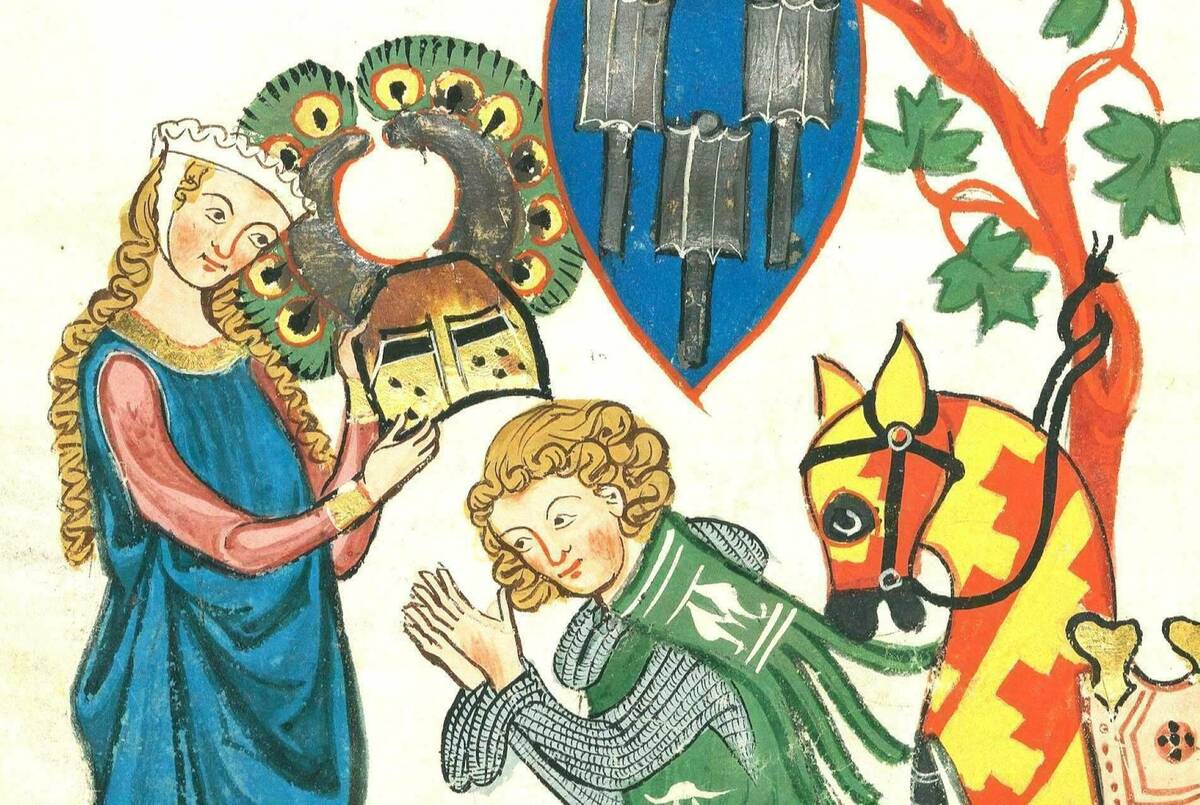The word “hackneyed” only begins to approach our habit of yoking John Ronald Reuel Tolkien (or better, his The Hobbit and The Lord of the Rings trilogy) to Lent. Both, some have remarked, represent a journey. His Middle Earth (and here the absent middle is Middle English itself) mirrors our own yeoman’s sojourn. Traversing immense evil, good lies at the end of each. As a hobbit (or ascetic of old), get rid of your shoes! Saussure himself would marvel at the structural parallels.
I do not mean to demean the impulse. We create the connections because they make sense (and because Tolkien’s books are such lavish, emotionally fraught adventures for our imaginations in a season-long pregnant with scampish joy and sullen despondency). In fact, I’d like to double down on this compulsion: what if we took seriously a connection not simply between Tolkien’s books and Lent but also that between his life, his passions, his career, and this Christian season of penitence?
If life is a pilgrimage toward death and Lent is a journey to the Cross and the empty tomb, then peregrinator Tolkien donned sackcloth and sprinkled ashes mostly at the University of Oxford, where he toiled and earned bangers and mash by the sweat of his furrowed brow—that is, teaching and thumbing through medieval manuscripts. Wouldn’t a truly Tolkienian Lent tarry with these fixations of his, the works he never seemed able to put down, indeed, the very stuff of his life?
I propose, then, to take a brief detour through what (in my field, medieval studies) is possibly his most famous and consequential work, the reverberations of which are still with us today. In examining this potentially moribund-seeming bit of philological investigation, we will find Lenten lessons, largely about desire and, above all, its displacement.
This is an erotic fixation, especially in medieval terms. This season demands Christians pick up their crosses and follow Christ. To do so, however, we must first put down what we are carrying now (worries, pains, pretensions) and set our eyes upon Easter morning. As we shall see, the work we set out to do—and Tolkien’s career shows this—is not always the work we end up doing. Christ redefines, displaces, our human, all too human, desires.
Tolkien’s Love (of) Language
Tolkien was a philologist. While his most famous scholarly work is certainly “Beowulf: The Monsters and the Critics,” a lecture committed to something like literary criticism, Ole J.R.R. concentrated much of his professional energy on more minute questions, things like morphology, stemmatics, and dialect reconstruction. To this end, his most important work within his chosen field of medieval studies remains 1929’s “Ancrene Wisse and Hali Meiðhad.”[1]
In keeping with this no-nonsense title, Tolkien’s article deals with highly specific lexical issues that would bore most people to tears. He believed he had discovered a dialect of early Middle English, meaning a coherent written standard for a local variant of the language in the period immediately following the Norman Conquest, which otherwise stymied textual production in English (the Normans spoke a version of French that we call “Anglo-Norman”). This dialect existed in two manuscripts from the beginning of the thirteenth century. One he called “A,” the other “B.” Their shared tongue he called (with the creativity of the philologist) “AB language.”
In an age where works had to be copied by hand, changes in spelling to match shifts in pronunciation were common. There was no written standard and dialects varied within only a few miles. Scribes also tended to make mistakes. The labor was repetitive; certain words might be foreign or confusing. Each new scribe copied from a manuscript made by an existing one. Textual transmission was thus one gigantic game of telephone, making it easy enough to go from coherent poem or sermon to half-intelligible mess within only a couple copyists. To find, as Tolkien did, a remarkably consistent set of conventions within a pair of manuscripts was unheard of for this period in England’s history because of war, conquest, and French domination. He found a golden goose (in medievalist terms, anyway):
At the very least we have here a closeness of relationship between the language and the spelling of two distinct MSS. and hands that is astonishing, if not (as I believe) unique. The two manuscripts are in fact in one language and spelling (AB). And this is found, as far as I am aware, nowhere else. That is, though it may be even a preponderating element in other texts, especially other versions of the same matter, it is not elsewhere found in isolation; nowhere else is it present in so consistent and regular a form, and in all its details of grammar and spelling.[2]
Lest we think Tolkien abandoned his discovery, he wrote or edited eleven pieces pertaining to the AB group all the way until 1962, only a decade before his death.[3] According to Michael D.C. Drout, Tolkien published on this topic more than any other; it forms over a third of all his available scholarly work. The man spent four decades of his life investigating this otherwise little-studied group of texts. What was in them? And why did he care so much?
Wooing Tolkien
Two manuscripts initially drew him in. First, MS Corpus Christi College 402, a rendering of Ancrene Wisse, a rule likely written by a cleric for three sisters seeking to become anchoresses, that is, women who lived solitary lives, usually in small cells attached to churches. Next, MS Bodley 34, a collection of saints’ lives and sermons, usually called the “Katherine Group” because one of these hagiographies is that of Saint Katherine. In the 1950s, W. Meredith Thompson would identify poems in British Museum MS Cotton Titus D.xviii that displayed similar characteristics.[4] This set (largely of poems) came to be called the “Wooing Group” after both its lead work, Þe Wohunge of Ure Laured (The Wooing of Our Lord) and the texts’ fixation on God’s beckoning the desire of his faithful.
It is this last point that matters the most for our Lenten journey. These texts are rife with exactly the sort of material we might imagine making Tolkien uncomfortable. In keeping with courtly romantic currents popular at the time, Jesus is figured as a handsome, loving knight who will save his (usually) female devotee from a life of carnality in sin by offering her the faithfulness, communion, and ecstasy of truer, higher love.
Before she can turn aside from secular things, these writers (who may be one person) must first apprise her of the dangerous traps ahead. The cleric behind Ancrene Wisse, for instance, hovers over the physical details of a secular dalliance:
Now along comes a man who is weak, but thinks he deserves respect if he has a wide hood and a closed cloak, and wants to look at young anchoresses, and absolutely has to see how the beauty of a woman, whose face is not sunburnt, appeals to him […His temptation,] the pit is her beautiful face, her white neck, her roving eyes, her hand, if she holds it out where [he] can see it.[5]
Anchoresses (though in other texts from the group perhaps other female religious or simply devout women) must be on guard against vanity too: “Admiring their own white hands is bad for many anchoresses who keep them too beautiful, such as those who have too little to do; they should scrape up the earth every day from the grave in which they will rot.”[6] This practice is but one among many intended to deter male suitors. Anchoresses are instructed to rebuke any man who opens their curtain and wishes them a good day and to change the subject immediately if a man uses more complicated (and self-effacing) strategies of seduction.[7]
This female devotee, however, is not alone. As we see in Þe Wohunge of Ure Laured, the surest way to avoid and defeat such temptation is displacement of desire for a possible lover (even if such desire manifests initially only through a glance or innocent remark) onto a desire for Christ as a lover. Here, then, the author encourages the reader to imagine Jesus in visceral, even sensual, terms:
Before Pilate, how you were stripped, bound fast to the pillar, so that you could in no way flinch from the blows; there you were beaten with knotted whips for my love, so that your lovely body could be all torn and rent; and all your blessed body flowed with one bloody stream […] (Now my heart can break apart, my eyes all overflow with water. Ah! Now is my lover condemned to die! Ah! now they lead him toward Mount Calvary, to the death-place. Ah! See, he bears his cross upon his bare shoulders—and, beloved, would that those blows would fall on me with which they strike you.[8]
Jesus is her lover, a man whose bare shoulders heave like those of a weightlifter, defiant of his enemies. The author dwells on blood, water, and the savagery of this beating, encouraging the reader to stay focused in minute detail on Jesus’s body and the suffering that it endured. Even this depiction of Christ is tame compared to more overt imaginings of him as a knight who saves his lady from danger, a quest often associated in secular courtly literature with sex. The texts in the Katherine Group are hagiographies and therefore, while not as personal, do show the saints as women who suffer broken bodies because of an eroticized love for Jesus. In all cases, these works request that the reader displace her desire for worldly love and reorient it toward Jesus. The authors offer strategies (ascetic and imaginary) to accomplish this goal.
Such physical, sometimes approaching sexual, language is ubiquitous in the AB language texts. No wonder, then, that Tolkien begins his original essay identifying them as a group with a blanket denial of any knowledge of literary-critical interest in them: “My interest in this document is linguistic.”[9] His interest might have been, but sometimes our interests have little to do with the results of our actions.
There and Back Again
Tolkien sought out and discovered the AB group because of his own interest in historical linguistic preservation, separate from the literary or artistic qualities of these texts. He wanted to isolate and understand the development of a dialect of the English language, denuded of anything erotic (at least in any way related to how that term is typically understood). It is ironic, then, that these texts today have been subject more than perhaps any others within the field of Middle English studies to the critical eyes of gender and queer theorists. It is no accident that I have thus far-cited essays with names like “Romancing the Anchorhold” and “Transvestitism in the Anchorhold.” These hermeneutics are unavoidable in a little corner of scholarship that owes its existence to confluences Tolkien noticed all the way back in 1925.
For his part, Tolkien would no doubt be repulsed by such approaches, as he was by his would-be student and later famed social theorist Stuart Hall’s desire to apply culturally attuned lenses to medieval literary texts in the 1950s.[10] But that’s precisely the point: Tolkien’s desire for philological tranquility was displaced just like that of the religious women within the AB group. He, like those present at the crucifixion, knew not what he did. Like Paul, his will to the good turned out to make real what he thought to be bad. His spirit betrayed him, as our desires always betray us. I do not know what I want, and, when I do, my effort toward it enacts something else entirely. Such is life; such is embodiment.
In this way, however, Lent also enters the picture. What we have here is precisely the goal of this most momentous of the Church’s liturgical seasons: the displacement of our typical worldly desires toward an often-slippery love of God. This is the lesson of these texts! When we fast and give alms (as we are called to do during Lent), we discipline the body to reorient the object of our desire. We become the addressees of the AB group, groping in darkness, trying to find our way away from mundane concerns and petty loves toward the summum bonum, if not toward becoming sponsae Christi.
A Tolkienian Lent, then, is one that recommits itself to desiring God, to recognizing the fungibility and fallibility of our merely human wants. Sometimes we recognize the existence of a dialect group among an obscure pair of medieval manuscripts that opens the way for a major current in medieval studies-based gender theory. Sometimes we turn away from the Lord toward secular pursuits—a suitor at the window of our cell, or one of the many distracting vicissitudes of everyday life. We cannot know the outcome of these erotic forces, but we can labor toward their displacement, their recalibration toward God as the object of our love, trusting in Providence that whatever comes will arrive, opening the way for us to greet it (like the Resurrection) with pious joy. In Lent, we march toward this goal, setting the risen Christ before our eyes even as we march through the trials of self-denial, the dark days of Passiontide.
In his article identifying the group, Tolkien off-handedly remarks, “But this, if true, possesses an interest for others than the linguistic analyst.”[11] Indeed, his discoveries did—more than he could have imagined.
[1] All citations from this article come from Tolkien, J.R.R. “Ancrene Wisse and Hali Meiðhad,” Essays and Studies 14.1 (1929), 104-126. This seminal essay was preceded by related work, especially “The Devil’s Coach-Horses,” for which, see Tolkien, J.R.R. “The Devil’s Coach-Horses,” Review of English Studies 1.3 (1925), 331-336.
[2] Tolkien, “Ancrene Wisse and Hali Meiðhad,” 108.
[3] See Drout, Michael D.C., “J.R.R. Tolkien’s Medieval Scholarship and Its Significance,” Tolkien Studies 4.1 (2007), 113-176, especially 174.
[4] Þe Wohunge Of Ure Lauerd. Edited from B.M. MS. Cotton Titus DXVIII together with On Ureisun Of Ure Louerde, On Wel Swuge God Ureisun Of God Almihti, On Lofsong Of Ure Louerde, On Lofsong Of Ure Lefdi, Pe Oreisun Of Seinte Marie from the manuscripts in which they occur, ed. W. Meredith Thomspon, (E.E.T.S., O.S. 241) London and New York: Oxford University Press, 1958.
[5] Ancrene Wisse / A Guide for Anchoresses: A Translation, ed. and trans. Bella Millett, Liverpool: Liverpool University Press, 2007, 22-23. All text in brackets is mine. Given that that this piece is for a non-medievalist audience, I am opting to use Millett’s translation rather than the original, which can be found here: https://d.lib.rochester.edu/teams/publication/hasenfratz-ancrene-wisse.
[6] Ibid., 46.
[7] Ibid., 38. See Petříková, Klára, “Romancing the Anchorhold: Romance Motifs in Ancrene Wisse, ‘Guide for Anchoresses,’” Philologica 2.1 (2022), 7-20 for a longer consideration of these themes in the text.
[8] Quoted in Salih, Sarah, “Transvestitism in the Anchorhold,” The Milieu and Context of the Wooing Group, ed. Susannah Mary Chewning, Cardiff: University of Wales Press, 2009, 148-164, 154-155. The text in brackets is my own. For the original, see ibid.
[9] Tolkien, “Ancrene Wisse and Hali Meiðhad,” 104.
[10] Hall, Stuart with Bill Schwarz, Familiar Stranger: A Life Between Two Islands. Durham: Duke University Press, 156.
[11] Tolkien, “Ancrene Wisse and Hali Meiðhad,” 106.


